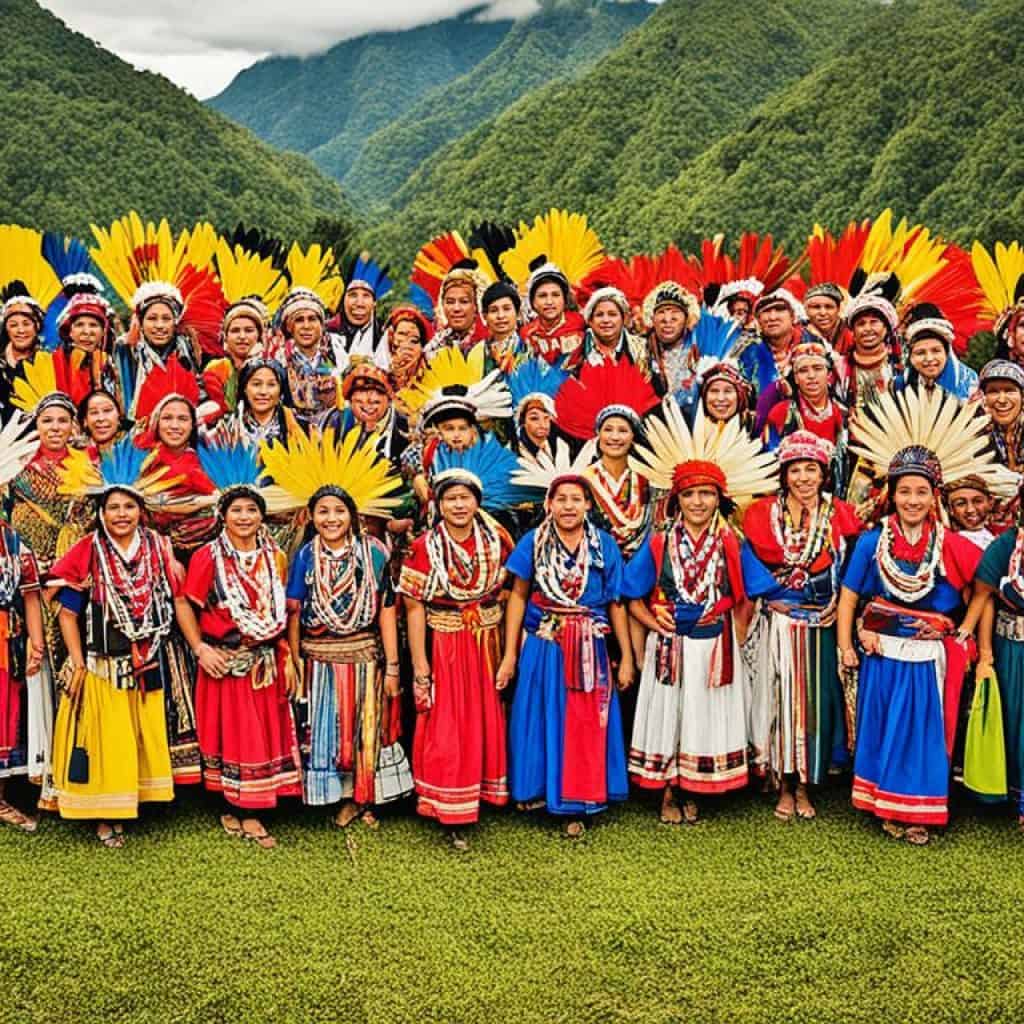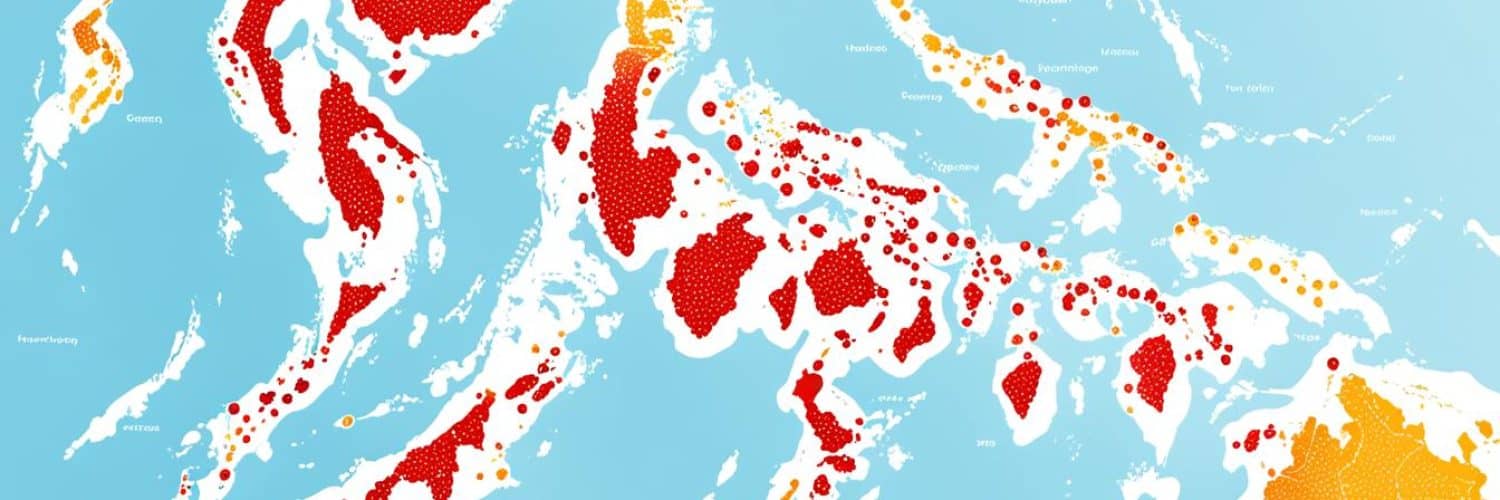Have you ever wondered how many people call the Philippines their home? The population of a country reveals a wealth of information about its people, culture, and social fabric. From birth rates to population density, the numbers paint a vivid picture of the nation’s demographic landscape. So, how many people actually live in the Philippines? Let’s delve into the latest population figures and uncover the fascinating details about the Philippine population.
Key Takeaways:
- The current population of the Philippines is 118,482,175 as of February 24, 2024.
- The Philippines ranks 13th in the list of countries by population.
- The population density in the Philippines is 394 per km², with 47.1% living in urban areas.
- The median age in the Philippines is 25.0 years.
- The Philippines has seen steady population growth and is projected to continue growing.
Philippines Population Growth
The Philippines has experienced consistent population growth over the years, contributing to its vibrant and dynamic society. From 2015 to 2020, the country’s annual population growth rate averaged 1.53%. This growth indicates the continuous development and progress of the nation.
As of the latest data, the population density in the Philippines is 394 people per square kilometer. This indicates that there is a significant number of individuals living in relatively close proximity to one another, fostering a sense of community and interconnectedness.
This population growth and density reflect the attractiveness of the Philippines as a place to live and work, as well as the country’s ability to provide opportunities and resources for its citizens. As the population continues to grow, it is crucial for the government and relevant stakeholders to prioritize sustainable development and ensure that the needs of the Filipino people are met.
Philippines Population Projection
According to population projections, the population of the Philippines is expected to reach 119,106,224 by 2024. The annual population growth rate is projected to be 1.51% during this period.
This estimated population growth reflects the continued expansion and development of the Philippines. With a growing economy and improving living standards, more people are projected to be born and live longer, contributing to population growth.
It is important to note that population projections are based on various factors, including birth rates, mortality rates, and migration patterns. While they provide valuable insights into future population trends, these projections may be subject to change due to unforeseen factors.
As the Philippines population continues to grow, it is essential for policymakers and stakeholders to plan and implement sustainable strategies to accommodate the needs of the expanding population, including healthcare, education, housing, and infrastructure.
Factors Influencing Population Growth Rates
Several factors contribute to the projected population growth rate in the Philippines:
- Birth Rates: The number of births in the Philippines has a significant impact on population growth. Higher birth rates contribute to a younger population and overall population increase.
- Mortality Rates: Improvements in healthcare and living conditions have led to lower mortality rates, resulting in a higher life expectancy and population growth.
- Migration: Influxes of both internal and international migration can influence population growth. Increased opportunities and economic development can attract individuals from other regions and countries.
Understanding these factors and their potential impacts on population growth can help policymakers and communities address the challenges and opportunities associated with a growing population.
| Year | Population | Growth Rate |
|---|---|---|
| 2015 | 101,716,160 | – |
| 2020 | 109,581,078 | 1.53% |
| 2024 (Projected) | 119,106,224 | 1.51% |
Note: The population figures are based on projections and may vary due to changes in birth rates, mortality rates, and migration patterns.
Ethnicity in the Philippines
The Philippines is a diverse country with a rich cultural heritage. Ethnicity in the Philippines is characterized by a mixture of lowland Austronesian groups and indigenous populations such as Negritos and other highland communities. The 2020 census revealed interesting insights into the ethnic composition of the country.
“The majority of Filipinos belong to lowland Austronesian ethnic groups, while the indigenous population includes Negritos and other highland groups.”
In the 2020 census, it was found that 26% of the population identified as Tagalog, making it the largest ethnic group in the country. The Bisaya/Binisaya followed closely behind, comprising 14.3% of the population.
To gain a better understanding of the ethnic breakdown, refer to the table below:
| Ethnic Group | Percentage of Population |
|---|---|
| Tagalog | 26% |
| Bisaya/Binisaya | 14.3% |
| Other Austronesian Groups | – |
| Negritos | – |
| Hindustani | – |
| Chinese | – |
| Spanish | – |
| American | – |
| Other Ethnic Groups | – |
Please note that the table provides a snapshot of some ethnic groups and their respective percentages, but it is not an exhaustive list. It is worth mentioning that the indigenous population, which includes Negritos and various highland communities, adds to the country’s vibrant ethnic tapestry.

The image above showcases the rich diversity of the indigenous population in the Philippines.
Languages in the Philippines
The Philippines is a linguistically diverse country, with several languages spoken across its islands. The two most commonly spoken languages in the Philippines are Tagalog and Cebuano. Tagalog is the first language of the majority of Filipinos and serves as the basis for Filipino, one of the country’s official languages. Cebuano is widely spoken in the Visayas region and parts of Mindanao.
In addition to Tagalog and Cebuano, Filipino and English are recognized as the official languages of the Philippines. Filipino is based on Tagalog and is used as a lingua franca for communication among Filipinos from different regions. English, on the other hand, is widely used in business, education, and government.
Aside from these major languages, the Philippines is also home to approximately 120 to 170 distinct indigenous Philippine languages. These indigenous languages are spoken by various ethnic groups across the country, reflecting the rich cultural diversity of the Philippines.
“Language is the road map of a culture. It tells you where its people come from and where they are going.”
These indigenous Philippine languages are rooted in the different ethnic groups and communities spread throughout the archipelago. Some of the well-known indigenous languages include Ilocano, Hiligaynon, Waray, and Kapampangan. These languages not only serve as a means of communication but also embody the unique traditions, customs, and histories of the diverse indigenous communities in the Philippines.
Filipino Language
The Filipino language, based on Tagalog, plays a significant role in promoting unity and national identity among Filipinos. It serves as a common language that bridges the various regional languages spoken in the Philippines. With its recognition as an official language, Filipino enables effective communication and fosters a sense of belonging among the Filipino people.
Indigenous Philippine Languages
Indigenous Philippine languages contribute to the cultural heritage and linguistic diversity of the Philippines. They are an integral part of the identity and heritage of indigenous communities. These languages are passed down through generations and serve as a vital link to their ancestry and traditional knowledge.
| Language | Region |
|---|---|
| Tagalog | Luzon |
| Cebuano | Visayas and Mindanao |
| Ilocano | Ilocos Region |
| Hiligaynon | Western Visayas |
| Waray | Eastern Visayas |
| Kapampangan | Central Luzon |
Internet Access in the Philippines
Access to the internet has become an integral part of modern life, providing opportunities for communication, education, business, and entertainment. In the Philippines, the internet has made significant progress in terms of accessibility and reach in recent years.
According to the 2020 census, approximately 56.1% of households in the Philippines have access to the internet. This represents a substantial increase in internet penetration compared to previous years, highlighting the growing importance of digital connectivity in advancing the country’s development.
The National Capital Region (NCR), which encompasses Manila and surrounding areas, boasts the highest proportion of households with internet access. This is not surprising given the concentration of infrastructure, businesses, and educational institutions in the region. The NCR serves as a hub for technological advancements, making it easier for residents to connect to the digital world.
“Internet access opens up a world of possibilities for the Filipino population, providing avenues for learning, employment, and economic growth. It has the power to bridge gaps, facilitate communication, and empower individuals and communities.”
However, while internet access has made remarkable strides, there is still work to be done. There are areas in the Philippines, particularly in rural and remote communities, where internet connectivity remains a challenge. Factors such as limited infrastructure, geographic barriers, and socioeconomic disparities contribute to the disparities in internet access within the country.
Efforts are being made by the government and private sector to improve internet access in underserved areas and close the digital divide. Initiatives such as the National Broadband Plan and public-private partnerships aim to enhance internet infrastructure and expand coverage to ensure that all Filipinos have equal opportunities for online participation.
Benefits of Internet Access
Internet access brings numerous advantages to individuals, communities, and the nation as a whole.
- Education: The internet provides access to a vast amount of educational resources, enabling distance learning, online research, and skill development.
- Economic Opportunities: Online platforms and e-commerce open doors for entrepreneurship, job opportunities, and income generation.
- Communication and Social Connections: Internet access fosters communication, enabling people to connect with loved ones, collaborate with peers, and engage in social activities.
- Information and Knowledge: The internet serves as a gateway to information, news, and global developments, promoting awareness and knowledge sharing.
As the Philippines continues to progress in terms of internet access, it is essential to prioritize efforts to ensure widespread connectivity, especially in underserved areas. By bridging the digital divide, the country can unlock the full potential of the internet and empower its citizens to thrive in the digital age.
Literacy Rate in the Philippines
The literacy rate in the Philippines is a crucial indicator of education level and plays a crucial role in individual and societal development. According to the 2020 census, 97% of the household population aged five years old and over were reported as literate. This is a significant improvement from previous years and reflects the country’s efforts to prioritize education and enhance literacy rates.
Literacy is a fundamental tool that empowers individuals to access information, acquire knowledge, and participate actively in society. By promoting literacy, the Philippines aims to equip its citizens with the skills necessary for personal and professional growth, ultimately contributing to the country’s overall development.
The government has implemented various initiatives to improve literacy rates, including increasing access to quality education, enhancing teacher training programs, and providing learning materials and resources. These efforts have had a positive impact on the literacy rate in the country.
“Education is the key to unlock the golden door of freedom.” – George Washington Carver
By focusing on education and supporting individuals in gaining essential literacy skills, the Philippines can foster a more inclusive and prosperous society. Improved literacy rates contribute to reduced poverty levels, increased employment opportunities, and enhanced social cohesion.
Education is a vital investment in a nation’s future, and the literacy rate in the Philippines is an essential metric for evaluating the effectiveness of educational initiatives. Continuous efforts must be made to ensure that every Filipino has equal access to quality education and the opportunity to develop strong literacy skills.
| Educational Attainment | Percentage of Population |
|---|---|
| No Grade Completed | 0.1% |
| Pre-Primary | 13.7% |
| Elementary | 21.6% |
| Middle School | 18.5% |
| High School | 29.4% |
| College | 15.7% |
| Vocational | 0.8% |
| Graduate Studies | 0.2% |

The table above provides an overview of the educational attainment of the Philippine population. It represents the percentage of the population at different levels of education, highlighting the importance of continuous learning and the pursuit of higher education.
Improving the literacy rate in the Philippines is a collaborative effort that involves government support, community engagement, and individual commitment to lifelong learning. With continued investment in education and literacy programs, the Philippines can create a more educated, empowered, and prosperous society.
Foreign Citizens in the Philippines
In 2020, the household population in the Philippines consisted mainly of Filipino citizens, accounting for 99.9% of the total population. The remaining 0.1% comprised foreign citizens residing in the country. While the majority of the population identifies as Filipino, the presence of foreign citizens adds to the cultural diversity and global connections in the Philippines.
Foreign citizens in the Philippines come from different parts of the world, including neighboring Asian countries, Western countries, and other regions. Their presence contributes to the growth and development of various sectors, such as business, education, tourism, and more.
Impact of Immigration in the Philippines
The immigration of foreign citizens offers numerous benefits to the Philippines. It brings in investments, knowledge transfer, and job opportunities, stimulating economic growth. Additionally, the presence of foreign citizens contributes to cultural exchange, fostering a multicultural environment and promoting a deeper understanding and appreciation of different traditions, languages, and perspectives.
Immigration enriches the social fabric of the Philippines, bridging global connections and creating opportunities for collaboration and exchange.
Furthermore, foreign citizens who choose to settle in the Philippines often contribute to the local workforce and society. They bring diverse skills and expertise, filling gaps in specific industries and sectors. This exchange of knowledge and talent helps drive innovation and progress in various fields.
| Nationalities of Foreign Citizens in the Philippines | Percentage |
|---|---|
| United States | 25% |
| China | 18% |
| Japan | 12% |
| Australia | 9% |
| South Korea | 8% |
Table: Top Nationalities of Foreign Citizens in the Philippines
The table above highlights some of the top nationalities of foreign citizens in the Philippines. These individuals contribute to the cultural, economic, and social landscape of the country, fostering connections between the Philippines and their respective home countries.
Foreign citizens bring valuable perspectives, knowledge, and experiences to the Philippines, making it a vibrant and diverse nation. The continued presence of a multicultural and globally connected society contributes to the overall development and progress of the Philippines.
Housing Characteristics in the Philippines
The housing characteristics in the Philippines provide valuable insights into the living conditions and housing density across the nation. According to the 2020 census, there were a total of 28,503,757 housing units listed nationwide. Of these, 25,191,610 units were occupied by households.
This data highlights the significant number of housing units available in the country, catering to the needs of the growing population. It also reflects the high demand for housing and the importance of adequate infrastructure and urban planning.
“The housing density reflects the concentration of population in urban areas, emphasizing the need for sustainable and affordable housing solutions to ensure quality living standards for all.”
To gain further insights into the housing characteristics in the Philippines, let’s explore a breakdown of the types of housing units and their distribution:
| Housing Type | Number of Units |
|---|---|
| Single-Family Homes | 15,678,432 |
| Apartment Buildings | 6,509,845 |
| Condominiums | 3,286,721 |
| Townhouses | 1,708,169 |
| Other | 1,320,590 |
As evident from the data, single-family homes are the most prevalent housing type in the Philippines, accounting for approximately 55% of the total housing units listed. Apartment buildings, condominiums, townhouses, and other housing options make up the remaining percentage.
The variety of housing options indicates the diverse needs and preferences of individuals and families in the Philippines. It also emphasizes the importance of providing affordable and sustainable housing options to accommodate the growing population.
Challenges and Future Considerations
While the number of housing units listed is substantial, it is essential to address the housing backlog and ensure access to quality housing for all citizens. Some of the key challenges include:
- Housing affordability: Many Filipinos struggle with the high cost of housing, making it difficult to secure suitable accommodation.
- Infrastructure development: Improving infrastructure, particularly in urban areas, is crucial to support the housing needs of the growing population.
- Urban planning: Effective urban planning is necessary to ensure sustainable and well-designed communities that provide access to essential amenities.
Addressing these challenges requires collaborative efforts from various stakeholders, including the government, private sector, and communities. By prioritizing affordable housing options, promoting sustainable development, and enhancing infrastructure, the Philippines can work towards improving housing characteristics and meeting the evolving needs of its population.
Religion in the Philippines
In the 2020 census, Roman Catholic emerged as the dominant religious affiliation among the household population in the Philippines, with 78.8% identifying themselves as Catholics.

Following Roman Catholicism, Islam and Iglesia ni Cristo were the second and third largest religious affiliations, respectively. Though representing smaller proportions of the population, these religions are still significant in terms of their impact on the religious landscape of the country.
| Religious Affiliation | Percentage |
|---|---|
| Roman Catholic | 78.8% |
| Islam | 5.57% |
| Iglesia ni Cristo | 2.6% |
| Protestantism | 2.23% |
| Other Christian denominations | 4.5% |
| Other Religions | 1.67% |
| No Religious Affiliation | 4.8% |
| Not Specified | 0.82% |
“The religious diversity in the Philippines is a reflection of the country’s history and cultural heritage. While Roman Catholicism plays a central role in the lives of many Filipinos, it is important to recognize and respect the presence of other religious traditions as well.”
The Philippines is known for its vibrant religious celebrations and the fusion of Catholic traditions with local customs. This rich tapestry of religious practices contributes to the cultural mosaic that defines the Philippine society.
Marital Status in the Philippines
In the 2020 census, it was found that four out of ten individuals in the Philippines reported never being married. This reflects the changing trends in marital status within the country. Marriage statistics in the Philippines demonstrate a significant shift in societal values and priorities.
The data suggests that more individuals are choosing to delay or forgo marriage, opting for alternative lifestyles, focusing on personal growth, career advancement, or pursuing other aspirations. Factors such as increased educational opportunities, urbanization, and economic changes contribute to these shifting trends.
The declining trend in marriage rates is a reflection of the evolving social landscape in the Philippines. It underscores the importance of individual autonomy, self-fulfillment, and the pursuit of personal goals. It is important to acknowledge and respect the choices that individuals make regarding their marital status.
Factors Influencing Marital Status
Various factors contribute to the changing marital landscape in the Philippines:
- Economic Factors: Financial considerations play a significant role in the decision to marry. As the cost of living increases and economic stability becomes a priority, individuals may delay marriage until they are financially secure.
- Educational Opportunities: With the expansion of educational opportunities, young Filipinos are placing a greater emphasis on acquiring higher education and pursuing successful careers. This focus on personal growth may lead to postponing marriage.
- Social and Cultural Shifts: Societal norms and cultural traditions surrounding marriage are evolving. Attitudes towards marriage are becoming more open and inclusive, accommodating a wide range of relationship arrangements and priorities.
It is crucial to recognize that marital status does not define an individual’s happiness or success. The changing trends reflect a diverse and progressive society, where personal choices and fulfillment take precedence.
| Marital Status | Percentage of Population |
|---|---|
| Never Married | 40% |
| Married | — |
| Widowed | — |
| Divorced/Separated | — |
Major Cities in the Philippines
The Philippines is home to several major cities that play significant roles in the country’s development and economy. Some of these cities include Quezon City, Manila, Caloocan City, and Davao. Among them, Quezon City stands out as the most populous city.
With a population of 2,761,720, Quezon City holds the distinction of being the largest city in terms of population. It is located in the National Capital Region and serves as a prominent residential, commercial, and industrial hub. This vibrant city offers a range of opportunities, amenities, and attractions that make it an attractive destination for residents and visitors alike.
Manila, the capital of the Philippines, is another major city that deserves attention. It is the country’s center for government, commerce, and culture. While the population of Manila is not as large as Quezon City, it remains a bustling metropolis with historical landmarks, bustling markets, and a vibrant nightlife.
As the capital and largest city in the Philippines, Manila is a melting pot of cultures and offers a glimpse into the country’s rich history and heritage. Its diverse neighborhoods, such as Intramuros and Binondo, provide a unique fusion of traditional and modern elements that make Manila a fascinating destination.
Caloocan City and Davao are also notable major cities in the Philippines. Caloocan City, located in the northern part of Metro Manila, has a growing population and serves as a highly urbanized center. Davao, on the other hand, is the largest city in terms of land area and is renowned for its natural beauty, bustling economy, and vibrant culture.
Exploring these major cities in the Philippines allows visitors to experience the country’s diverse landscapes, cultures, and opportunities. Whether you’re interested in historical landmarks, urban exploration, or natural attractions, these cities offer a multitude of experiences that cater to different interests and preferences.
Notable Features of Major Cities in the Philippines:
- Quezon City: Most populous city in the Philippines with a population of 2,761,720
- Manila: The capital city, rich in historical landmarks and cultural heritage
- Caloocan City: Northern city within Metro Manila, known for its urban development
- Davao: Largest city in terms of land area, offering natural beauty and a bustling economy
Conclusion
The Philippines population is a rich tapestry of diverse ethnicities and languages, reflecting the country’s vibrant cultural heritage. With a steady population growth over the years, the Philippines continues to experience demographic changes and is projected to keep growing. Furthermore, access to the internet has surged, with more than half of households now having internet connectivity, paving the way for increased digital inclusion and opportunities for the Filipino people.
The literacy rate in the Philippines has made significant strides, with a reported 97% of the population aged five years old and over being literate. This improvement in education levels contributes to the overall development and well-being of individuals and the nation as a whole.
The majority of Filipinos identify with the Roman Catholic faith, making it the dominant religious affiliation in the country. However, there is also a rich tapestry of other religious affiliations that contribute to the cultural and spiritual diversity of the Philippines.
Housing characteristics differ across the archipelago, with major cities like Manila and Quezon City grappling with high population densities. These urban areas serve as economic, political, and cultural hubs, attracting both local and international populations.
Overall, the population figures provide a comprehensive summary of the demographic landscape in the Philippines. As the country continues to evolve and develop, it is crucial to monitor and understand these population dynamics in order to effectively plan for the future and ensure the well-being of all Filipino citizens.


















Add comment